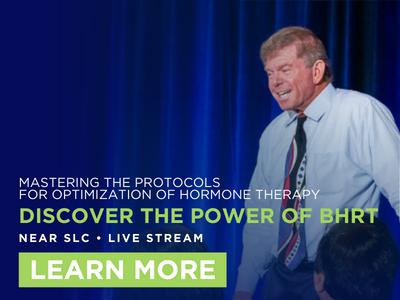
6 Important Qualities to Look For in Hormone Replacement Training
Written by Krista Russ

We have explored the pandemic of chronic illness that patients are experiencing. We have also explored how hormone replacement therapy can safely and effectively prevent or even treat many chronic illnesses by delving into the robust medical literature supporting hormone replacement. After learning how Bioidentical Hormone Replacement Therapy (BHRT) can help patients fight chronic disease, providers may ultimately desire to add this form of medicine to their practice, so how do they go about doing that? The answer: training, of course.
As with any other medical treatment, in order to learn how to properly and safely administer BHRT, providers must be well-versed in hormone therapy protocols and understand situations in which it could be beneficial.
Choosing a reputable training program is no easy feat though, as not all training programs are created equal. To make this process easier, we have compiled a list of qualities to help determine if a program is reputable and worthwhile.
1. The Training is Evidence-Based
Any reputable training program should be steeped in evidenced-based research. All conclusions derived about prescribing, monitoring, and adjusting doses should be based on facts and rooted in the scientific literature. Furthermore, understanding the “why” and “how” behind treatment protocols is imperative because there is often disagreement even within the hormone replacement field itself. For example, many experts disagree on whether or not to test serum or saliva labs. A reputable training program will elucidate the pros and cons of all perspectives and remain unbiased. Because hormones are not a black and white topic, maintaining a balanced perspective is very important. Without knowing all the facts about a subject, it is not possible to treat someone effectively. Therefore, a program that gives the ins and outs of what makes a particular mode of treatment effective is clearly essential.
2. Flexible Learning Options
A great training program will not only be effective in its teachings but will also be flexible. For example, does the training offer a remote option, where participants can attend the training from anywhere in the world? This may be preferred for some, especially in the current COVID pandemic. For others, who learn better through face-to-face interaction, a live attendance option is invaluable. Moreover, in-person interactions allow people to truly connect with each other and engage in a community. A sense of community also fosters a deeper, more immersive learning experience. Another question providers should ask is how interactive is the training? A training program that allows for both live and remote participation, such as a chat log, where participants can pose questions to the speaker, will not only facilitate learning, but promote continued engagement throughout the training.
There are other considerations still. What is the speaker’s style and tone, and does this align with personal learning style? Some speakers may be more reserved, while others are more gregarious and love sharing real life examples. Often, this is where humans find the most value and connection because it’s relatable.
Training that provides the highest quality faculty, curriculum, and course materials for an affordable price is clearly a winner. This means the training is “value-priced”, or priced according to its value.
Lastly, how is the training sequenced? Do the courses build upon one another gradually and allow time to go out in the field and practice what was learned so the knowledge is really solid before moving onto the next part? Does the training allow for flexible consumption, meaning that it can be completed on the provider’s time and the provider can go at their own pace? In simpler words, does the training “meet them where they are”? These are all factors that should empower provider’s decision-making.
3. Be Able to Prescribe, Monitor, and Adjust Dosages After Completion
How often have providers attended a CME Accredited conference and come away feeling like they learned something but not enough to put it into practice? Or perhaps, they understand the need to prescribe or recommend the product but really don’t know the “why” or “how” behind prescribing, monitoring, and adjusting treatments. Ideally, providers should invest in a program that ensures they are adequately prepared after completing the training. This means they are fully equipped with the knowledge and resources needed to begin treating patients. To ensure that learning how to prescribe, monitor, and adjust treatments will be taught, providers should examine the agenda and make sure it mentions these items beforehand.
4. Achieve Mastery in BHRT Knowledge
After completing a course, what knowledge does a provider walk away with? Do they feel that they’ve truly mastered the subject matter or instead, do they feel that they’ve barely scratched the surface? This is important to consider when weighing one’s training options. Some courses may be very brief. For example, an 8 or 10 hour course is unlikely to go into much detail. However, a course that is in excess of 60 hours is more like a college- course in terms of the breadth and depth of knowledge gained. A 4-credit hour college course is about 60-70 hours a semester, so looking at the total number of hours of training is a great way to put things into perspective. Another important question to ask is how many hours consisted of seeing valuable content, or “learning time”, as opposed to meeting with vendors, breaks, side conversation, etc. A course that is more learning-driven is sure to deepen one’s knowledge-based compared to a course that is lighter. Walking away with the feeling of truly mastering the subject matter not only makes providers more confident in practice but also enshrines a deep sense of personal accomplishment.
Furthermore, if having a certification program to test knowledge and establish credibility with patients is important, then looking for a program with a certification process is invaluable. Not only does a reputable certification symbolize one’s personal accomplishment, similar to a diploma or degree, but having something tangible to highlight the provider’s achievements is a great confidence boost to both the provider and patient, who will have deeper faith in the provider’s acumen.
5. Ongoing Support AFTER Completion
Along with this mastery, does the provider have a community of supporters at their disposal to bounce thoughts and ideas off of? Some programs provide this in the way of chat forums and discussion boards which can not only augment the learning experience by providing a means for human interaction but also provides valuable collaboration.
As the industry shifts, and studies reveal new insights, how will the provider stay up to date with the latest protocols? A reputable training institution will provide a means to keep up with the ever-changing science, so that they can stay in the know and treat their patients using the most updated protocols possible. For example, are any case studies offered? Case studies are a great way to apply the knowledge learned during the training.
What happens when a provider has a case that is very complex and additional instruction is needed? Are there other resources for them, such as a support staff member, they can contact? Not being left out in the woods to struggle with complex cases by ourselves is certainly of benefit, and one that few programs offer, so this is particularly important to pay attention to.
6. Personalized Approach to Hormone Therapy
There are a number of hormone replacement training approaches available, but selecting a training that teaches a personalized approach is ideal. A personalized approach means the approach is patient-focused and focuses on optimizing hormones over achieving “normal” levels. “Optimizing hormones” means finding a hormone dosage that is best for the patient and adequately addresses their underlying symptoms; it does not restrict treatment based on arbitrary levels. Evidence-based medicine shows us that cellular resistance at the cell level (for example, disrupted cell signal transduction, membrane issues, or receptor issues) can result in symptoms of low hormone status even when levels fall within the “normal” range. Furthermore, the normal range is often very broad and may not reflect a person’s individual genetic makeup and ability to metabolize and utilize said hormones. A training program that teaches optimizing hormones to the level needed to actually help the patient is sure to be a powerful differentiator for any provider practicing hormone replacement therapy.
Next Steps
Now that the items to look for in a comprehensive hormone replacement training have been discussed, what are the next steps? Weigh the pros and cons of each option, consider the six qualities discussed, and choose the hormone replacement training program that aligns most with your personal career goals. Keeping these steps in mind, you are sure to have success.
If you are ready to start considering your BHRT training options, please consider our Hormone Optimization Workshop Series.
